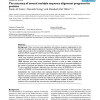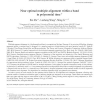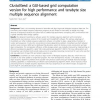20 search results - page 2 / 4 » Multiple sequence alignments of partially coding nucleic aci... |
BMCBI
2006
13 years 5 months ago
2006
Background: Since the publication of the first draft of the human genome in 2000, bioinformatic data have been accumulating at an overwhelming pace. Currently, more than 3 million...
BMCBI
2006
13 years 5 months ago
2006
Background: Multiple sequence alignment is the foundation of many important applications in bioinformatics that aim at detecting functionally important regions, predicting protein...
BMCBI
2006
13 years 5 months ago
2006
Background: There have been many algorithms and software programs implemented for the inference of multiple sequence alignments of protein and DNA sequences. The "true" ...
STOC
2000
ACM
13 years 9 months ago
2000
ACM
Multiple sequence alignment is a fundamental problem in computational biology. Because of its notorious difficulties, aligning sequences within a constant band (c-diagonal) is a ...
BMCBI
2010
13 years 5 months ago
2010
Background: There is an increasing demand to assemble and align large-scale biological sequence data sets. The commonly used multiple sequence alignment programs are still limited...



